The Burning Man will be the solar plexus of a giant horizontal body laid out in laser beams thirty feet above the playa, in the shape of our logo. This technology is being engineered by Russel Wilcox of Lawrence Livermore Laboratories, participant at Burning Man since 1996. His original design, a solar powered electric car, was featured in the Burning Man documentary video “Flashback.”
Russell created the Tetrahedron art installation in 1999, a 25-foot tall laser sculpture using mirrors mounted on towers, describing a three-dimensional geometric figure in light beams. Laser engineer, designer of a major subsystem for a billion-dollar laser project, holder of four patents on lasers and related devices, inventor of new methods of creating light pulses for Laser Fusion which have been applied to Fusion lasers around the world, and designer and builder of optical/laser devices for science education, Russell is also a video cinematographer and editor, and is a former film grad student at SF State University.

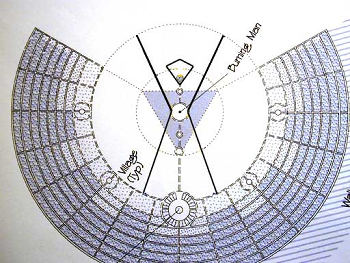
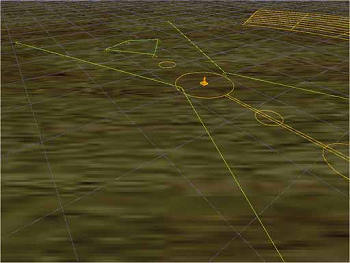
Technical Description
The laser installation uses solid state lasers and optics to create stationary laser beams that describe a simple line drawing 30 feet above the ground, the logo of The Man. Three lasers are split into two beams each. On each side, a laser creates an arm and a leg, coming from a laser source tower at the waist, and absorbed at his hands and feet. In the head, a laser source at the top of the head splits into two beams that reflect off mirrors at his ears and both are subsequently absorbed at his chin, forming the four-sided head. Lasers are housed in enclosures on the ground, and elevated to 30 feet using mirrors in a periscope arrangement.
The complication of this project is in the large scale. Since the longest beams (arms and legs) are 2000 feet long, the optical system must have very high stability to maintain the beam on special targets several feet wide, where the light energy is safely absorbed. With the beams reflecting from mirrors mounted on top of 30 foot towers, mechanical stability of these structures is essential. The size of the mirrors is limited to six inches or less for cost reasons, and the size of the targets is limited to less than six feet for wind force reasons.
Slight changes in temperature or ground settling will misalign the beams to the point where they miss either mirrors or targets, so automatic alignment control is necessary. The beam absorbing targets have sensors which measure the beam position and report back to controllers which move motorized mirrors to compensate for misalignment. If a beam moves completely off a sensor or is blocked for some reason, the sensor will tell the laser sources to shut off that particular beam for safety reasons. The mirror towers (at the ears) also have sensors as well as mirror controllers, so that all the beams in the head are automatically aligned. Communication between towers is by radio, digitally encoded using microprocessors that read x-y analog position data and overall beam power.
The automatic control system can adjust for slow changes in mirror position, but not rapid vibrations, which must be minimized by direct mechanical means. Commercially available guy wired transmitting towers are assumed for the moment to deliver adequate performance for reasonable cost. In addition, the source towers (with the lasers at the bottom) are supported such that the tower can tilt about a pivot at the bottom, rather than flexing with a rigid mount into the ground. This forms a rigid periscope which will maintain constant beam angle even if the tower sways. Still, the top of the 30 foot tower can only move a few millimeters.
Due to the hostile dust environment, optics at the tops of the towers are protected by enclosures with motorized doors during the day, and opened only during nightly operation. The lasers and associated optics are housed in an enclosure along with recirculating water cooler and control electronics, powered by generators in sound-absorbing enclosures. Generator boxes need to be baffled to route exhaust away from air inlets and prevent overheating. All optical components in the laser enclosure are mounted on a rigid steel beam, which ensures stable delivery of the beams to the source tower periscope.
With high quality lasers and optics, a beam diameter of about one inch can be maintained over the 2000 foot arms and legs. A slightly smaller beam may be used for the head, to reduce stability requirements of the mirror towers. High quality beams will require high quality optics and mounts, and precise alignment procedures when the installation is set up.
This installation will be an engineering feat, but initial analysis shows it is feasible within our budget, schedule, and technical capability.
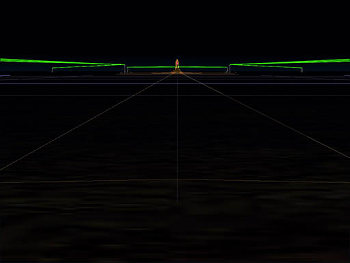
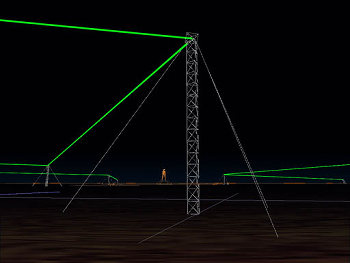
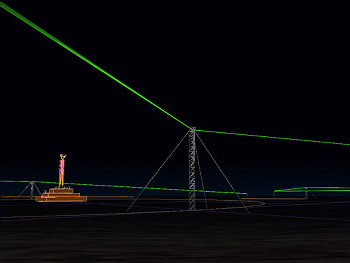
Volunteer
following volunteers:
Mechanical Engineer
Experience/skills: Designing and building metal mechanical structures from 1 to 30 feet in size. Quantitatively characterizing vibration and other instabilities (settling, thermal expansion) of large structures especially ones anchored to ground. Experience with microwave antenna towers or laser optical systems a plus.
Job description:
Design and build mechanical structures for laser/optical hardware and towers. Design towers for high stability, quantify stability performance (vibration frequencies and amplitudes) and work with electrical and optical engineers to optimize control system requirements. Specify and purchase commercial components or draw up special components to be made. Ensure tower and laser mount performance given adverse temperature, wind, and soil conditions, while minimizing cost. Design electromechanical doors, laser blocking devices, optic holders, wooden enclosures for lasers and electrical generators, and other components. Build and test prototype equipment, working with electrical and optical designers. Construct or manage construction of all towers and other mechanical equipment. Help install and troubleshoot at site, before and during the event. Share in glory.
Electrical Engineer
Experience/skills: Designing and building analog or digital feedback control systems. Experience with wireless digital data transmission, RF systems, analog/digital data conversion and signal processing, RF noise suppression, high precision DC and servomotor controls. Real-world construction and troubleshooting of working systems.
Job description:
Design and build electronic controls for laser/optical hardware. Design laser sensor/motorized mirror control system for high stability, quantify stability and work with mechanical and optical engineers to optimize control system requirements. Specify and purchase electrical components or special components to be made. Ensure electronic controls performance given adverse environmental conditions, while minimizing cost. Design analog position signal detection, RF transmission, signal processing and motor control equipment, working with mechanical and optical designers. Construct or manage construction of all electronic parts and other electrical equipment. Help install and troubleshoot at site, before and during the event. Share in glory.
Metal Fabricator/Mechanical Technician
Experience/skills: Fabrication of steel and aluminum parts using a variety of materials and techniques including machining and welding.
Job description:
Make special metal parts according to drawings, from 1 inch to several feet in size. Assemble prototype 30-foot towers with high structural integrity. Work with mechanical, optical and electrical engineers to maximize manufacturability and minimize cost.
Wood Fabricator
Experience/skills: Construction or cabinet making a plus.
Job description:
Build wood enclosures for laser equipment and gas powered electrical generators, about 4x4x8 feet maximum, working from drawings. Enclosures must be clean on the inside, weatherproof, and accessible through doors for maintenance.
Installation Crew (4 or 5 in addition to above personnel)
Experience/skills: Assembly and erection of large structures, especially towers. Facility with mechanical and electrical equipment and tools. Assemble and erect 30-foot metal towers, install guy wires, ground anchors. Use cherry picker to install equipment on tops of towers. Assemble laser and generator enclosures, protective fences around towers. Help with laser alignment and testing.
Operation Crew
Experience/skills: Ability to dissuade miscreants, ride bicycle, understand generally how installation works.
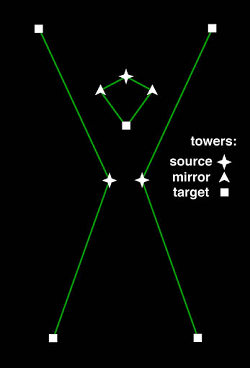
Job description:
Ensure proper operation of installation once it’s activated each night of the event. Prevent attendees from interacting with installation, especially laser beams and towers. Prevent climbing of towers, building of fires under beams, throwing of objects into beams etc. Use bicycles to patrol length of beam paths. Learn characteristics of proper operation and report to engineering staff via radio in case of problems.

